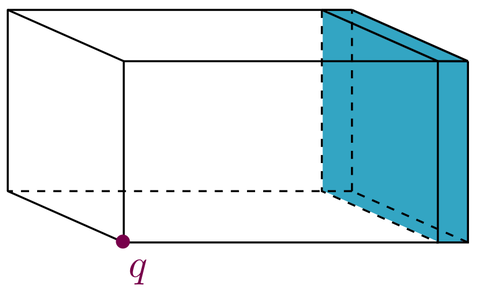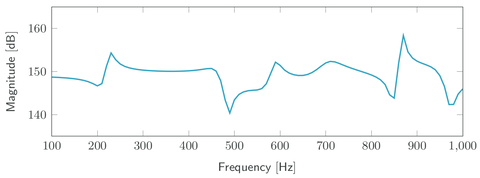 Note: This page has not been verified by our editors.
Note: This page has not been verified by our editors.
Description
The Porous absorber benchmark models the sound pressure in a cavity excited by a single harmonic load. One side of the cavity is covered by a layer of poroelastic material, which adds dissipation to the system. The geometry of this model follows [1]. Various projection-based model order reduction methods have been applied and compared using this example as a benchmark in [2].
The cavity has the dimensions  and one wall is covered by a
and one wall is covered by a  thick poroelastic layer acting as a sound absorber. The poroelastic material is described by the Biot theory[3] and the system is excited by a point source located in a corner opposite of the porous layer. The material parameters for the acoustic fluid and the poroelastic material have been chosen according to[1]. The transfer function measures the mean acoustic pressure inside the cavity.
thick poroelastic layer acting as a sound absorber. The poroelastic material is described by the Biot theory[3] and the system is excited by a point source located in a corner opposite of the porous layer. The material parameters for the acoustic fluid and the poroelastic material have been chosen according to[1]. The transfer function measures the mean acoustic pressure inside the cavity.
Dimensions
System structure:
with the frequency dependent functions for the effective densities  , the parameter
, the parameter  relating the effective densities and the frequency dependent elasticity coefficients to the porosity, and the scaled effective bulk modulus
relating the effective densities and the frequency dependent elasticity coefficients to the porosity, and the scaled effective bulk modulus  . For more details on the functions, see [1].
. For more details on the functions, see [1].
System dimensions:
 ,
,
 ,
,
 ,
with
,
with  .
.
Data
The data is available at Zenodo.
Remarks
- The numerical model resembles the results from[1] in a frequency range from
 to
to  . The frequency response in this range is also included in the dataset.
. The frequency response in this range is also included in the dataset. - The finite element discretization has been performed with Kratos Multiphysics.
- A comparison of different interpolation-based MOR methods using this benchmark example is available in[2].
Citation
To cite this benchmark, use the following references:
- For the benchmark itself and its data:
@Misc{dataAum23,
author = {Aumann, Q.},
title = {Matrices for an acoustic cavity with poroelastic layer},
howpublished = {hosted at {MORwiki} -- Model Order Reduction Wiki},
year = 2023,
doi = {10.5281/zenodo.8087341}
}
- For the background on the benchmark:
@Article{AumW23,
author = {Aumann, Q. and Werner, S.~W.~R.},
title = {Structured model order reduction for vibro-acoustic problems using interpolation and balancing methods},
journal = {Journal of Sound and Vibration},
volume = 543,
year = 2023,
pages = {117363},
doi = {10.1016/j.jsv.2022.117363},
publisher = {Elsevier {BV}}
}
References
- ↑ 1.0 1.1 1.2 1.3 R. Rumpler, P. Göransson, J.-F. Deü. "A finite element approach combining a reduced-order system, Padé approximants, and an adaptive frequency windowing for fast multi-frequency solution of poro-acoustic problems", International Journal for Numerical Methods in Engineering, 97: 759-784, 2014.
- ↑ 2.0 2.1 Q. Aumann, S. W. R. Werner. "Structured model order reduction for vibro-acoustic problems using interpolation and balancing methods", Journal of Sound and Vibration, 543: 117363, 2023.
- ↑ M. A. Biot. "Theory of propagation of elastic waves in a fluid-saturated porous solid. I. Low-frequency range", J. Acoust. Soc. Am., 28(2):168–178, 1956.


 .
.
